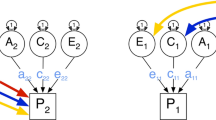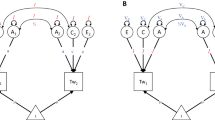Abstract
Given that knowledge regarding the etiology of comorbidity between disorders can have a significant impact on research regarding the classification, treatment, and etiology of the disorders, the ability to reject incorrect hypotheses regarding the causes of comorbidity is very important. A simulation study was conducted to assess the validity of the Neale and Kendler (1995) model-fitting approach in examining the etiology of comorbidity between two disorders. First, data were simulated under the assumptions of the 13 alternative comorbidity models described by Neale and Kendler. Second, model-fitting analyses testing the comorbidity models were conducted on the simulated datasets. Thirteen sets of data with varying model parameters were simulated to test Neale and Kendler's assertion that their model-fitting approach is appropriate across a range of potential prevalences and degrees of familiality. The validity of the model-fitting approach in examining unselected twin data and a combination of selected family data and unselected family data was explored. The model-fitting approach successfully discriminated several classes of comorbidity models, although discrimination between models within classes of related models was less accurate. Results suggest that the model-fitting approach can be a useful tool in examining the etiology of the comorbidity between disorders if the caveats of the present study's results are considered carefully. As predicted by Neale and Kendler, variations in the disorder prevalences and familial correlations did not affect the validity of their model-fitting approach, but affected the power to discriminate the correct model. As suggested by Neale and Kendler, the model-fitting approach can be applied to both unselected and selected data and to both twin and family data.
Similar content being viewed by others
References
American Psychiatric Association. (1994). Diagnostic and Statistical Manual of Mental Disorders, 4th ed. Washington, D. C.: American Psychiatric Association.
Battaglia, M., Bernardeschi, L., Politi, E., Bertella, S., and Bellodi, L. (1995). Comorbidity of panic and somatization disorder: A genetic-epidemiological approach. Compr. Psychiatry 36:411-420.
Berkson, J. (1946). Limitations of the application of fourfold table analysis to hospital data. Biometrics 2:47-53.
Biederman, J., Faraone, S. V., Keenan, K., Benjamin, J., Krifcher, B., Moore, C., Sprich-Buckminster, S., Ugaglia, K., Jellinek, M. S., Steingard, R., Spencer, T., Norman, D., Kolodny, R., Kraus, I., Perrin, J., Keller, M. B., and Tsuang, M. T. (1992). Further evidence of family-genetic risk factors in attention deficit hyperactivity disorder: Patterns of comorbidity in probands and relatives in psychiatrically and pediatrically referred samples. Arch. Gen. Psych. 49:728-738.
Bierut, L. J., Dinwiddie, S. H., Begleiter, H., Crowe, R. R., Hesselbrock, V., Nurnberger, J. I., Porjesz, B., Schuckit, M. A., and Reich, T. (1998). Familial transmission of substance dependence: Alcohol, marijuana, cocaine, and habitual smoking. Arch. Gen. Psychiatry 55:982-988.
Duffy, D. L., and Martin, N. G. (1994). Inferring the direction of causation in cross-sectional twin data: Theoretical and empirical considerations. Genet. Epidemiol. 11:483-502.
Fergusson, D. M., Lynskey, M. T., and Horwood, L. J. (1996). Origins of comorbidity between conduct and affect disorders. J. Am. Acad. Child Adolesc. Psychiatry 35:451-460.
Heath, A. C., Kessler, R. C., Neale, M. C., Hewitt, J. K., Eaves, L. J., and Kendler, K. S. (1993). Testing hypotheses about direction of causation using cross-sectional family data. Behav. Genet. 23:29-50.
Hewitt, J. K., and Heath, A. C. (1988). A note on computing the chisquare noncentrality parameter for power analyses. Behav. Genet. 18:105-108.
Hewitt, J. K., and Neale, M. C. (1989). A simple simulation procedure for exploring genetic models [Abstract]. Behav. Genet. 19:763-764.
Klein, D. N., and Riso, L. P. (1993). Psychiatric disorders: Problems of boundaries and comorbidity. In Costello, C. G. (ed.), Basic Issues in Psychopathology (pp. 19-66). New York: The Guilford Press.
Lilenfeld, L. R., Kaye, W. H., Greeno, C. G., Merikangas, K. R., Plotnicov, K., Pollice, C., Rao, R., Strober, M., Bulik, C. M., and Nagy, L. (1998). A controlled family study of anorexia nervosa and bulimia nervosa: Psychiatric disorders in first-degree relatives and effects of proband comorbidity. Arch. Gen. Psychiatry 55:603-610.
Maier, W., Lichtermann, D., and Minges, J. (1994). The relationship between alcoholism and unipolar depression: A controlled family study. J. Psychiatr. Res. 28:303-317.
Merikangas, K. R., Stolar, M., Stevens, D. E., Goulet, J., Preisig, M. A., Fenton, B., Zhang, H., O'Malley, S. S., and Rounsaville, B. (1998). Familial transmission of substance use disorders. Arch. Gen. Psych. 55:973-979.
Morton, N. E. (1982). Outline of Genetic Epidemiology. Basel: Karger.
Neale, M. C., Boker, S. M., Xie, G., and Maes, H. H. (1999). Mx: Statistical Modeling, 5th ed. Richmond, VA: Department of Psychiatry, Virginia Commonwealth University.
Neale, M. C., and Cardon, L. R. (1992). Methodology for Genetic Studies of Twins and Families. Dordrecht, The Netherlands: Kluwer Academic Publishers.
Neale, M. C., and Kendler, K. S. (1995). Models of comorbidity for multifactorial disorders. Am. J. Hum. Genet. 57:935-953.
Newman, D. L., Moffitt, T. E., Caspi, A., Magdol, L., Silva, P. A., and Stanton, W. R. (1996). Psychiatric disorder in a birth cohort of young adults: Prevalence, comorbidity, clinical significance, and new case incidence from ages 11 to 21. J. Consult Clin. Psychol. 64:552-562.
Pearson, E. S., and Hartley, H. O. (1972). Biometrika Tables for Statisticians (Vol. 2). Cambridge: Cambridge University Press.
Pennington, B. F., Groisser, D., and Welsh, M. C. (1993). Contrasting cognitive deficits in attention deficit hyperactivity disorder versus reading disability. Dev. Psychol. 29:511-523.
Rhee, S. H., Hewitt, J. K., Corley, R. P., and Stallings, M. C. (2003). The validity of analyses testing the etiology of comorbidity between two disorders: A review of family studies. J. Child Psychol. Psychiatry 44:612-636.
Rijsdijk, F. V., Cardno, A. G., Sham, P. C., and McGuffin, P. (1999, October). Statistical Aspects of Genetic Models of Comorbidity of Psychotic Disorders in Selected Twin Samples. Poster presented at the annual meeting of the International Society of Psychiatric Genetics. Monterey, CA.
Rutter, M. (1997). Comorbidity: Concepts, claims and choices. Crim. Behav. Ment. Health 7:265-285.
SAS Institute Inc. (1985). SAS User's Guide: Basics, Version 5 Edition. Cary, N.C.: SAS Institute Inc.
Schachar, R., and Tannock, R. (1995). Test of four hypotheses for the comorbidity of attention-deficit hyperactivity disorder and conduct disorder. J. Am. Acad. Child Adolesc. Psychiatry 34:639-648.
Scheffé, H. (1959). The Analysis of Variance. New York: John Wiley & Sons, Inc.
Silberg, J., Rutter, M., Meyer, J., Maes, H., Hewitt, J., Simonoff, E., Pickles, A., Loeber, R., and Eaves, L. (1996). Genetic and environmental influences on the covariation between hyperactivity and conduct disturbance in juvenile twins. J. Child Psychol. Psychiatry 37:803-816.
Simonoff, E., Pickles, A., Meyer, J. M., Silberg, J. L., Maes, H. H., Loeber, R., Rutter, M., Hewitt, J. K., and Eaves, L. J. (1997). The Virginia Twin Study of Adolescent Behavioral Development: Influences of age, sex, and impairment on rates of disorder. Arch. Gen. Psychiatry, 54:801-808.
Author information
Authors and Affiliations
Rights and permissions
About this article
Cite this article
Rhee, S.H., Hewitt, J.K., Lessem, J.M. et al. The Validity of the Neale and Kendler Model-Fitting Approach in Examining the Etiology of Comorbidity. Behav Genet 34, 251–265 (2004). https://doi.org/10.1023/B:BEGE.0000017871.87431.2a
Issue Date:
DOI: https://doi.org/10.1023/B:BEGE.0000017871.87431.2a




